When it comes to keeping my office, storefront, or outdoor space clean, I’ve learned that the right trash can isn’t just a container. It’s about convenience, hygiene, and even the impression it leaves on visitors. Over the years, I’ve tested dozens of options, and I want to share what I’ve learned about choosing the best commercial outdoor trash can.
Here’s a quick roadmap of what you’ll learn:
- Features that make a commercial outdoor trash can great
- Different types, and when I use them
- How to pick the right size and material
- Common mistakes I’ve made (so you won’t)
- Maintenance tips that actually work
- Extra considerations for outdoor placement
In This Guide, I’ll Cover
ToggleWhat Makes a Commercial Outdoor Trash Can “The Best”?
From my experience, the best trash cans go beyond holding waste. I focus on a few key traits:
Durability: Outdoor cans face sun, rain, wind, and occasional bumps. I personally choose heavy-duty plastic or coated steel. They withstand daily wear without cracking or rusting. They withstand daily wear without cracking or rusting—similar to how I select the best outdoor garbage can for my home.”
Capacity: I’ve learned the hard way that size matters. Too small, and I’m constantly emptying; too large, and it looks awkward in a small area. Matching capacity to foot traffic is crucial.
Design & Safety: Covers keep odors contained and pests out. Dome lids, swing tops, or even dual compartments for recycling are lifesavers. I also consider user-friendly openings so anyone can use them without struggle.
Mobility & Maintenance: Some cans need to be moved around. Handles, wheels, or lighter materials make life easier. And yes, a good liner system reduces mess and odor instantly.
Types of Commercial Outdoor Trash Cans
Over the years, I’ve tried several types of commercial outdoor trash cans, and I’ve learned that each has its own advantages depending on where and how it’s used. Here’s a detailed breakdown of what I use and recommend:
1. Metal Trash Cans

Material & Build: Usually made of steel or aluminum, often powder-coated to resist rust. Some even come with reinforced rims to prevent dents.
Usage:
I usually place these in high-traffic areas where durability is critical. This includes shopping mall entrances, office building exteriors, bus stops, and public parks. I also find them useful near restaurants or food courts because they can handle the occasional heavy or bulky trash, much like the best trash can for public spaces. In my experience, they’re perfect for areas that experience frequent public use or even minor vandalism because they don’t easily dent or get damaged.
Pros: Extremely durable, weather-resistant, professional look
Cons: Heavy, higher cost, can rust if the coating is scratched
Maintenance Tips: Clean weekly, touch up scratches, secure lids & handles
2. Plastic / Polyethylene Trash Cans
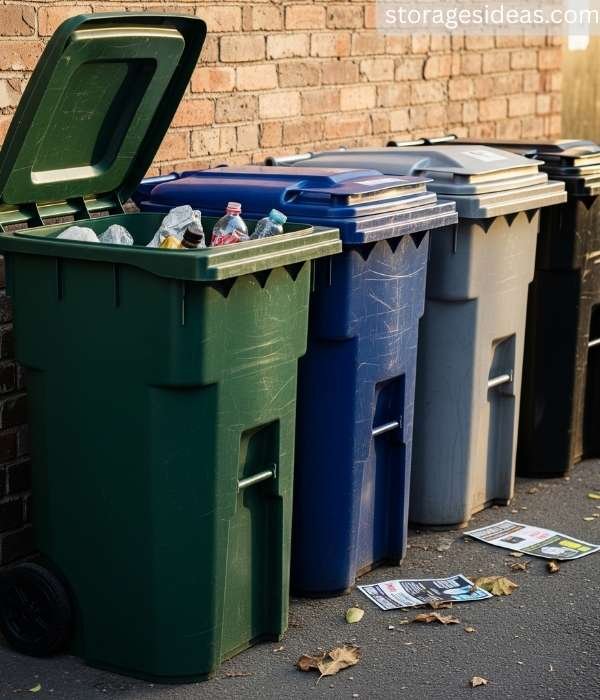
Material & Build: Made from high-density polyethylene (HDPE) or other heavy-duty plastics. Some are UV-resistant to prevent fading.
Usage:
I prefer these for medium-traffic zones such as school yards, community centers, sidewalks, or patios. Because they’re lightweight, I can move them during events or cleanings without too much effort. I also use them for seasonal outdoor areas, like pop-up markets or outdoor cafés, where mobility and cost-effectiveness matter.
Pros: Lightweight, rust-proof, affordable
Cons: Can crack under impact, may fade in the sun, less “premium” look
Maintenance Tips: Rinse regularly, inspect for cracks, replace liners promptly
3. Concrete Trash Cans
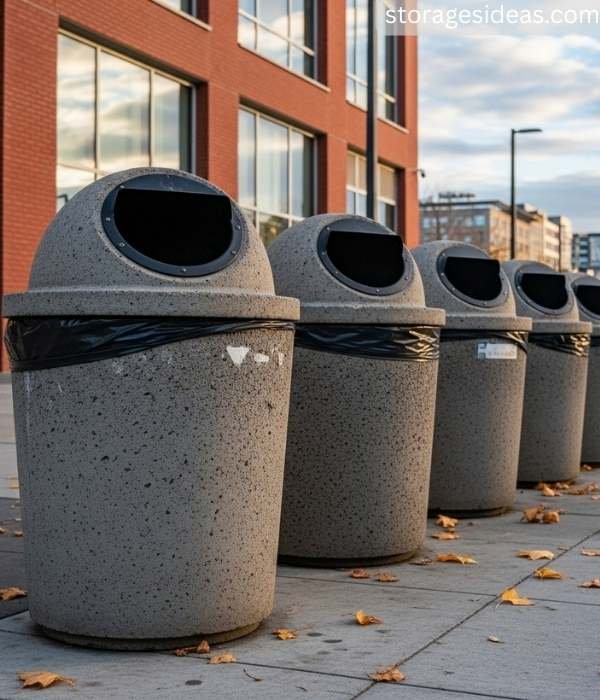
Material & Build: Made from poured concrete or concrete composite materials, often with a metal or plastic liner inside.
Usage:
Concrete cans are my go-to for permanent outdoor installations. I use them in parks, plazas, college campuses, and urban sidewalks where the cans should never be moved. Because they’re heavy, they’re perfect for areas that may face vandalism or strong winds. I’ve even seen them in large outdoor stadiums and recreational areas where public traffic is high and the can must stay in place at all times.
Pros: Extremely sturdy, tamper-resistant, blends with the landscape
Cons: Very heavy, expensive, can chip or crack
Maintenance Tips: Inspect liner regularly, clean interior, seal cracks promptly
4. Recycling & Multi-Compartment Bins
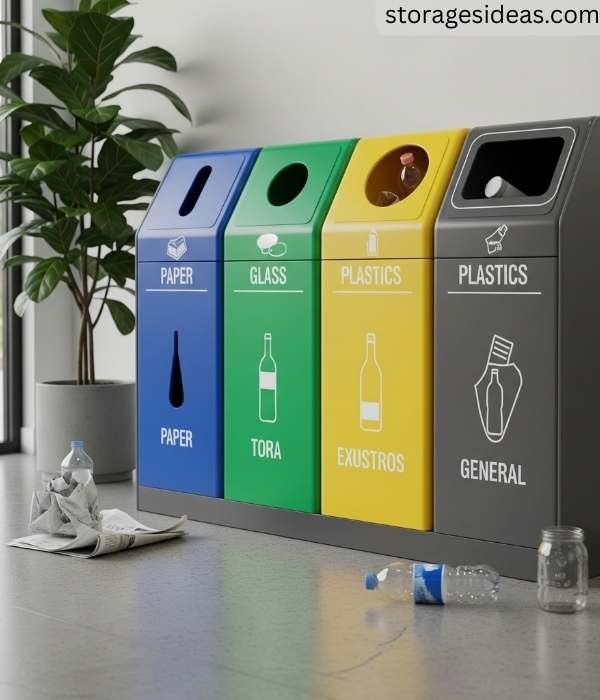
Material & Build: Can be metal or plastic, usually with two or more compartments labeled for paper, plastic, and general waste.
Usage:
I place these in offices, schools, hospitals, airports, and shopping malls where I want to encourage recycling. They work well in cafeterias, conference areas, or lobbies with foot traffic that generates paper, plastics, or aluminum waste. I make sure they’re in visible locations and clearly labeled, which improves proper use. They’re also handy for community events where multiple waste streams need to be sorted quickly.
Pros: Encourages proper waste separation, color-coded lids
Cons: Compartments can overflow if not emptied regularly, user error, and higher cost
Maintenance Tips: Label clearly, empty frequently, and clean openings
5. Smart / Sensor Trash Cans
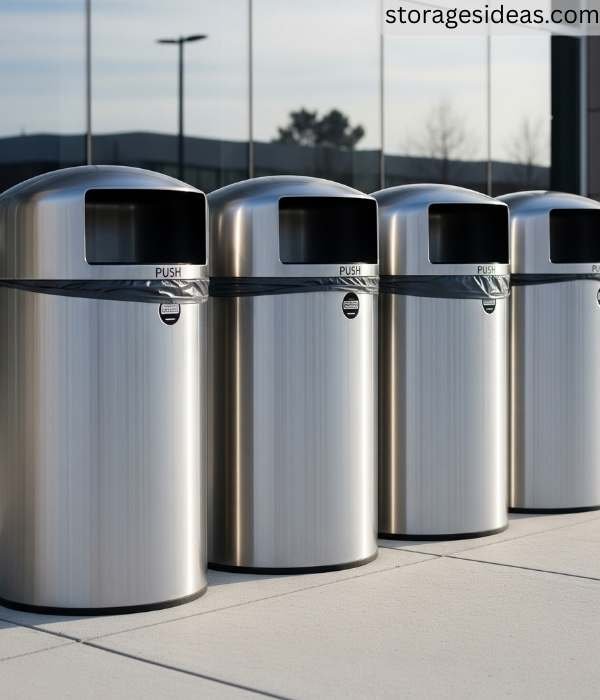
Material & Build: Typically made of plastic or metal, equipped with motion sensors that open lids automatically. Some have solar-powered options.
Usage:
I usually deploy these in high-touch or hygiene-sensitive areas. Examples include hospital entrances, gyms, cafeterias, hotels, and airports. They’re especially useful in places where hands-free operation improves sanitation and reduces the spread of germs. I also like to place them in tech-forward office spaces or modern urban plazas where a touch of innovation is appreciated.
Pros: Hands-free, modern, reduces contact, odor control
Cons: Needs battery/sensor maintenance, costly, sensitive to weather
Maintenance Tips: Check sensors/batteries, clean sensor area, keep lid hinges debris-free
6. Wooden Trash Cans
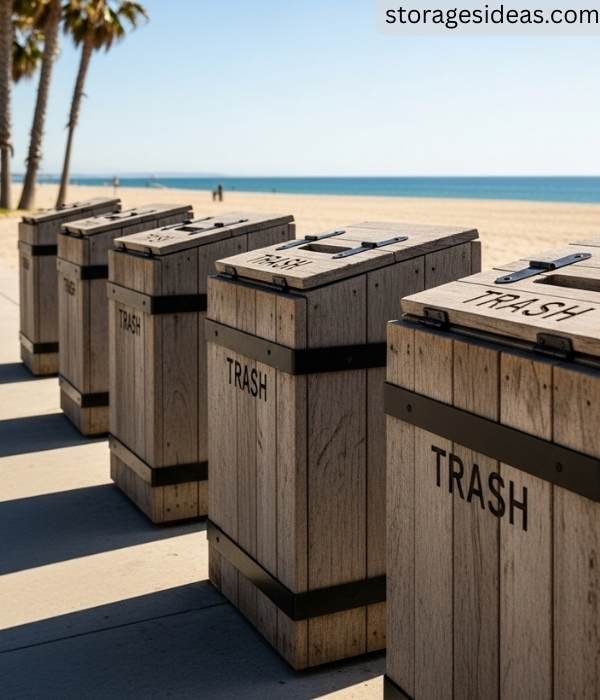
Material & Build: Treated wood with a metal liner and protective coating.
Usage:
I like to place wooden trash cans in outdoor areas where aesthetics matter, like hotel patios, botanical gardens, or boutique shopping streets. They blend naturally with landscaping and give a warmer, more upscale feel.
Pros: Attractive, complements landscaping, durable if treated properly
Cons: Requires regular treatment, heavier than plastic, more expensive
Maintenance Tips: Treat wood with sealant annually, check for splintering, and replace the liner regularly
7. Decorative Trash Cans
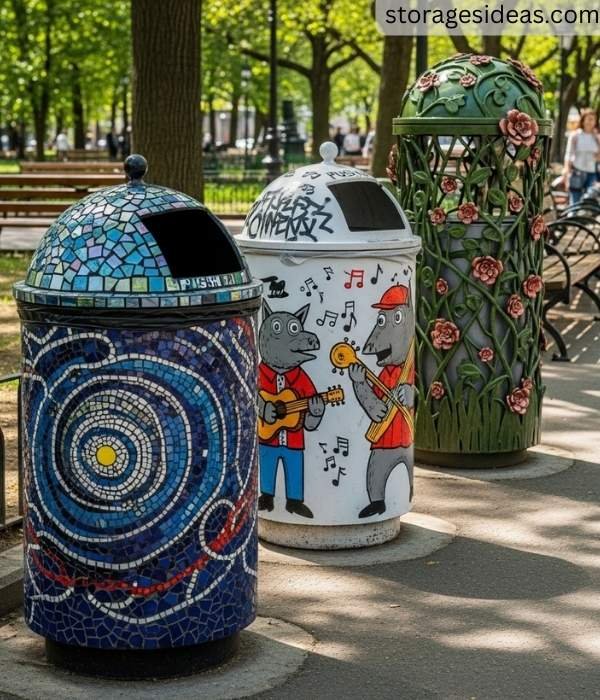
Material & Build: Made from metal, resin, or mixed materials with artistic designs or themed décor.
Usage:
I use decorative trash cans in plazas, outdoor malls, or tourist attractions where appearance is as important as function. These cans encourage people to use them while adding visual appeal to the area.
Pros: Enhances aesthetics, encourages proper usage, and various styles
Cons: Can be pricey, harder to clean, and have a smaller capacity depending on design
Maintenance Tips: Clean surfaces regularly, inspect paint/coating, and ensure liner accessibility
8. Capacity-Consideration Trash Cans
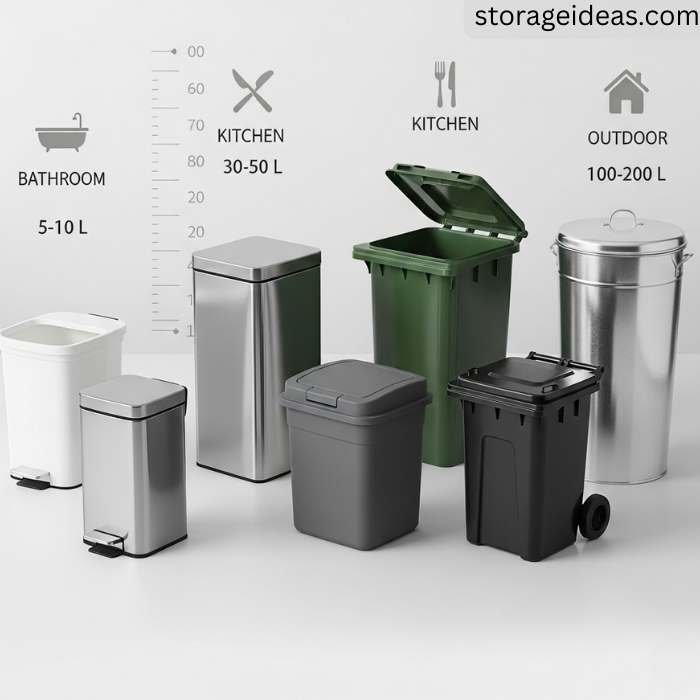
Material & Build: Can be metal, plastic, or concrete; the main focus is matching size to waste volume.
Usage:
I always consider foot traffic before choosing this type. Busy outdoor event spaces, stadium entrances, or large corporate campuses require large-capacity bins. Smaller versions work well in quiet garden paths or side entrances. Choosing the right capacity prevents overflow, reduces maintenance frequency, and keeps spaces cleaner.
Pros: Matches size to expected waste, reduces overflow, optimizes maintenance
Cons: Too large can be cumbersome; too small leads to frequent emptying; can look awkward if poorly sized
Maintenance Tips: Evaluate foot traffic regularly, use appropriate liners, and account for seasonal surges
Mini Comparison Table
| Type | Material | Ideal Usage | Pros | Cons | Maintenance Tips |
| Metal | Steel / Aluminum | High-traffic areas, parks, office entrances | Durable, weather-resistant, professional look | Heavy, higher cost, can rust | Clean weekly, touch up scratches, secure lids & handles |
| Plastic | HDPE / heavy-duty plastic | Schools, patios, seasonal events | Lightweight, rust-proof, affordable | Can crack, may fade, less premium look | Rinse, inspect cracks, replace liners |
| Concrete | Concrete/composite | Parks, plazas, permanent locations | Extremely sturdy, tamper-resistant | Very heavy, expensive, and can chip | Inspect liner, clean interior, seal cracks |
| Recycling / Multi-Compartment | Metal / Plastic | Offices, schools, hospitals, events | Promotes recycling, color-coded lids | Overflow if not emptied, user error | Label clearly, empty frequently, and clean openings |
| Smart / Sensor | Plastic / Metal with sensors | Hospitals, gyms, airports, plazas | Hands-free, modern, and reduces contact | Needs battery maintenance, costly | Check sensors, clean the area, and keep the hinges debris-free |
| Wooden | Treated wood | Hotel patios, gardens, boutique streets | Natural look, complements landscaping | Requires treatment, heavier, and more costly | Seal annually, check for splintering, and replace the liner |
| Decorative | Metal / Resin / Mixed | Plazas, malls, tourist attractions | Enhances aesthetics, encourages use | Pricey, harder to clean, smaller capacity | Clean surfaces, inspect coating, check liner |
| Capacity-Based | Metal / Plastic / Concrete | High-traffic events, stadiums, corporate campuses | Matches size to waste, reduces overflow | Too large or too small can be problematic | Evaluate traffic, use correct liner, consider seasonal surges |
Picking the Right Size and Material
Size and material are my top priorities now. I’ve made mistakes before—buying a sleek, small bin for a busy walkway only to find it overflowing in hours. Here’s my approach:
- Match Size to Foot Traffic:
- Small (10–20 gallons) for quiet areas or side entrances
- Medium (30–50 gallons) for moderate traffic
- Large (60+ gallons) for busy commercial spaces, parks, or plazas
- Small (10–20 gallons) for quiet areas or side entrances
- Consider Material Based on Environment:
- Metal/steel: High durability, professional look, slightly heavier
- Plastic/polyethylene: Lightweight, rust-proof, budget-friendly
- Concrete: Extremely sturdy, mostly permanent placements
- Metal/steel: High durability, professional look, slightly heavier
- Placement & Accessibility:
I make sure the trash can isn’t blocking walkways. Easy access encourages use, while inconvenient placement leads to littering. - Weather Resistance:
Sun, rain, snow—these are the real enemies. I always pick materials that won’t crack, warp, or rust easily. Investing upfront saves replacement costs later.
Common Mistakes I’ve Made
- Choosing Too Small a Can: Overflowing bins are messy and unprofessional.
- Ignoring Covers or Lids: Open-top bins attract pests fast. I now always use a lid.
- Overlooking Liners: A good liner makes cleaning easy and prevents odors.
- Focusing Only on Looks: That shiny designer bin may look great, but it can be fragile. Function first.
- Wrong Placement: Placing a bin far from traffic or entrances reduces its use. Convenience matters.
Maintenance Tips That Work
- Regular Cleaning: Rinse and scrub cans weekly to prevent odors.
- Check Hardware: Handles, lids, and wheels can loosen. Tighten monthly.
- Liner & Bag Replacement: Use high-quality liners and replace when full.
- Seasonal Checks: Inspect for cracking in winter or fading in summer.
- Pest Prevention: Covered lids and quick emptying prevent critters.
- Extra tip: placing a small deodorizer or baking soda at the bottom helps control smells. Works surprisingly well in public-facing areas.
Extra Considerations
- Signage: Clear labels encourage correct use, especially for recycling.
- Accessibility: ADA-compliant heights and openings make bins usable for everyone.
- Integration: Matching bin design with benches or planters for a consistent look.
- Cost vs Longevity: A slightly more expensive bin often lasts years longer than a cheap alternative. Treat it as an investment, not an expense.
Why Investing in the Best Commercial Outdoor Trash Can Matters
From experience, skimping on quality leads to mess, frequent replacement, and dissatisfied visitors. A solid trash can saves time, reduces pest issues, and improves the perception of your business or property. I now think of them as small ambassadors of cleanliness—they quietly do their job while I focus on bigger tasks.
My Takeaway
Choosing the best commercial outdoor trash can isn’t complicated if you know what to look for. I focus on durability, size, material, and ease of use. Avoid common mistakes, maintain your cans, and consider additional factors like placement and signage.
A little thought up front prevents a lot of headaches later. Trust me, the right bin can make a surprisingly big difference.

